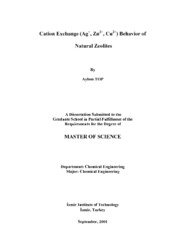Please use this identifier to cite or link to this item:
https://hdl.handle.net/11147/3712| Title: | Cation Exchange (ag+, Zn2+, Cu2+) Behavior of Natural Zeolites | Authors: | Top, Ayben | Advisors: | Ülkü, Semra | Publisher: | 01. Izmir Institute of Technology | Abstract: | In this study, clinoptilolite, most abundant zeolite present in nature, was proposed as a low cost antibacterial material. As a preliminary work, antibacterial activities of the original, Ag, and Zn forms of the clinoptilolite were investigated against several strains and compared to the commercial antibiotics. No antibacterial action was observed for the original clinoptilolite. Ag loaded clinoptilolite was found to be superior to the Zn-form against Proteus spp. and Pseudomonas aeruginosa.The original, Na, Ag, Zn, and Cu forms of the clinoptilolite samples were characterized by FTIR spectroscopy, thermal analyses (TGA, DTA, and DSC), and N2 physisorption studies. Specific attention was given in to the chemical analysis of the clinoptilolite by ICP-AES. Using the standard addition method, the respective idealized formulas of the original and Na-clinoptilolite based on 72 oxygen atoms in the unit cell were calculated as:(Na0.816 K2.070) (Ca1.060 Mg0.264) (Al5.653 Fe0.390) (Si30.084) O72. 20.023 H2O, and (Na4.763 K1.057) (Ca0.076 Mg0.094) (Al5.843 Fe0.221) (Si29.911) O72.17.049 H2O.In the FTIR spectra of the original and exchanged forms of the clinoptilolite, considerable shifts (from 3460 to 3494.8 cm-1) were observed in the band, which is formed due to the interactions of water molecules with the framework via hydrogen bonds. The positions of the other bands were not affected by cation exchange significantly. From the TGA curves, the water contents ranged between 14.31 and 11.00 % for the original and the cation-exchanged forms of the clinoptilolite. Mainly, two endotherms and one exotherm were obtained in the DTA curves. The first endotherm occurred up to about 150 oC, the second endotherm lied between 200 and 700 oC, and the exotherm was obtained at about 850 oC. Significant differences observed between the shapes of the DSC curves indicated that the cations control the dehydration behavior of the samples. N2 physisorption isotherms of five samples were all, Type IV with BET surface areas ranging between 34.97 and 46.76 m2/g.Ag, Zn and Cu ion exchange equilibria were investigated at 25 oC for both the original clinoptilolite and Na-clinoptilolite. In the former case, from the plateau of the isotherms cation exchange capacities were determined as 1.184, 0.439, 0.539 meq/g clinoptilolite for Ag+, Zn2+, and Cu2+ respectively. The major portion of the exchanges was contributed by Na+ and Ca2+. Distribution coefficient values indicated that at Ag, Zn and Cu ion exchange equilibria were investigated at 25 oC for both the original clinoptilolite and Na-clinoptilolite. In the former case, from the plateau of the isotherms cation exchange capacities were determined as 1.184, 0.439, 0.539 meq/g clinoptilolite for Ag+, Zn2+, and Cu2+ respectively. The major portion of the exchanges was contributed by Na+ and Ca2+. Distribution coefficient values indicated that at relatively low initial concentrations, the preference of the clinoptilolite for Zn2+ and Cu2+ was significant. At higher concentrations, higher distribution coefficients were obtained for Ag+ compared to Zn2+ and Cu2+. Langmuir and Freundlich models were applied for each equilibrium data. For Zn2+ and Cu2+ exchanges, Langmuir model gave better correlation and Freundlich model fitted experimental data slightly better in the case of Ag+ exchange.Equilibrium isotherms for Ag+-Na+, Zn2+-Na+, and Cu2+-Na+ pairs were investigated. Silver exchange isotherm lied above the diagonal over the whole composition range. For zinc and copper exchanges, the isotherms were above the diagonal up to equivalent fractions of exchanging ion in solution phase (As) at about 0.2. While full exchange was attained for silver, partial exchanges were obtained in the case of zinc and copper. The standard free energy of exchange values were found as .6.0, 2.03 and 3.09 kj/equiv for Ag+-Na+, Zn2+-Na+, and Cu2+-Na+ pairs respectively. From these values selectivity sequence was obtained as Ag+ > Na+ > Zn2+ > Cu2+.Consequently, by considering the preliminary antibacterial activity results, specific cation exchange capacities, and selectivity sequence of the clinoptilolite, Ag-clinoptilolite seemed to be promising antibacterial material. The results of the current study compared to the literature data pointed out that cation exchange behavior of the clinoptilolite is dependent on its original cationic composition. Therefore, it is necessary to carry out specific studies on representative samples from the deposit before any practical application. | Description: | Thesis (Master)--İzmir Institute of Technology, Chemical Engineering, Izmir, 2001 Includes bibliographical references (leaves: 75-81) Text in English; Abstract: Turkish and English xv, 103 leaves |
URI: | http://hdl.handle.net/11147/3712 |
| Appears in Collections: | Master Degree / Yüksek Lisans Tezleri |
Files in This Item:
| File | Description | Size | Format | |
|---|---|---|---|---|
| T000039.pdf | MasterThesis | 2.32 MB | Adobe PDF |  View/Open |
CORE Recommender
Page view(s)
462
checked on Jul 21, 2025
Download(s)
128
checked on Jul 21, 2025
Google ScholarTM
Check
Items in GCRIS Repository are protected by copyright, with all rights reserved, unless otherwise indicated.